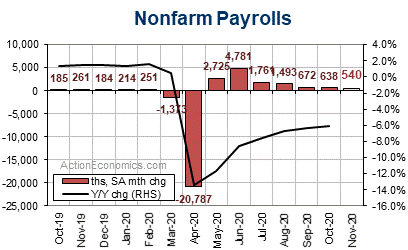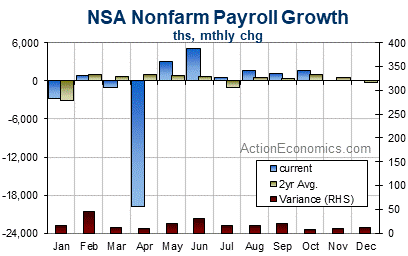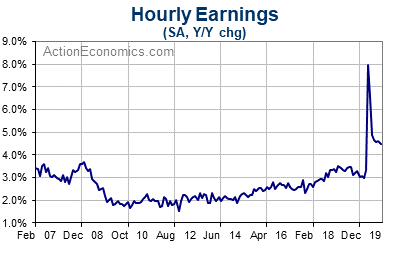The November Nonfarm payroll report is expected to show a gain at 540k, while the risk that heightened headwinds from rising COVID-19 cases may have been partly captured in the November survey. According to ActionEconomics estimates the median November payroll forecast is 490k, which is below the 540k estimate, with a range of 320k to 700k. Meanwhile the jobless rate is to hold steady at 6.9% in October, alongside a 0.5% November hours-worked rise with a 34.8 workweek. The hourly earnings are forecasted to rise 0.1%, as the measure gives back more of the 4.7% April pop with the shift in the composition of jobs back toward lower-paid workers.

The 540k Nonfarm payroll forecast assumes a 650k private jobs increase. The goods based employment increase is pegged at 125k, construction employment is seen rising 65k, while factory jobs rise 55k, private service job increase of 650k in November, and a 110k government employment decline due to a further -93k drop in temporary Census jobs, alongside continued weakness in education employment.
The seasonal impact to the average payroll change throughout the year is mostly positive, but is negative in December, January and July. The NSA average falls to 544k in November from 1,009k in October, 364k in September, and 456k in August. The red bars show each month’s variance. After a first-half peak in February, variance decreases over the spring before reaching a mid-year peak in June, then tapers off again over the remainder of the year.

For disruptions to employment from weather as gauged in the household survey, the biggest disruptions occur in the winter months generally with the average peaking in February. As usual in 2020, any weather related disruptions will be eclipsed by COVID-19.
Hourly Earnings
As stated earlier, November’s average hourly earnings is seen at 0.1% growth after figures of 0.1% in October and unchanged in September, as we further unwind the 4.7% April surge. Job losses have been skewed toward lower paid retail, leisure and hospitality workers, and this prompted the April spike in average hourly earnings that is now being reversed. Such outcome will lead to 4.2% y/y increase in November from 4.5% in October. Growth in hourly earnings was gradually climbing from the 2% trough area between 2010 and 2014 to the 3%+ area until the economy’s plunge in March. As shutdown distortions dissipate, the underlying cyclical uptrend will presumably fall back to the 2% area, though y/y gains will be distorted through 2021 via the comparison effects from year’s Q2 wage spike and ensuing unwind.

Nevertheless, yesterday one of the best indicator for Nonfarm payrolls, the ADP Survey, came a little below expectations, as there had been fears of a much weaker number with some worries over a negative print given the weakness in initial jobless claims and the drop in the ISM employment component into contractionary territory as virus cases surge and lockdowns are reinstituted. The ADP reported private payrolls rose 307k in November after increasing 404k (was 365k) previously. Strength remained in the service sector which added 276k jobs, with gains were fairly broadbased. Though payroll gains are moderating, there were fears of job losses this month given the indications from some of the high frequency data and the second wave of virus and lockdowns.
Click here to access the Economic Calendar
Andria Pichidi
Market Analyst
Disclaimer: This material is provided as a general marketing communication for information purposes only and does not constitute an independent investment research. Nothing in this communication contains, or should be considered as containing, an investment advice or an investment recommendation or a solicitation for the purpose of buying or selling of any financial instrument. All information provided is gathered from reputable sources and any information containing an indication of past performance is not a guarantee or reliable indicator of future performance. Users acknowledge that any investment in Leveraged Products is characterized by a certain degree of uncertainty and that any investment of this nature involves a high level of risk for which the users are solely responsible and liable. We assume no liability for any loss arising from any investment made based on the information provided in this communication. This communication must not be reproduced or further distributed without our prior written permission.



















